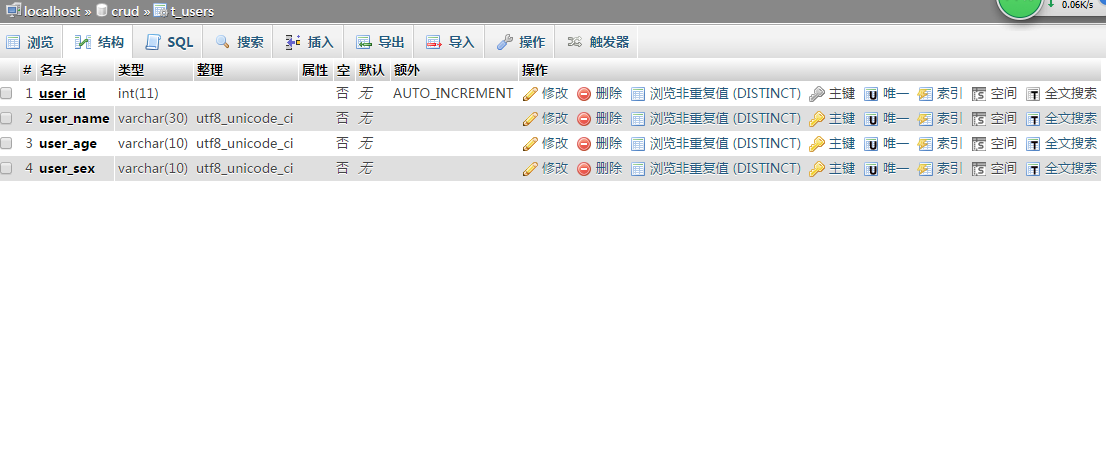java中的properties文件是一种配置文件,主要用于表达配置信息,文件类型为*.properties,格式为文本文件,文件的内容是格式是"键=值"的格式,在properties
文件中,可以用"#"来作注释,properties文件在Java编程中用到的地方很多,操作很方便。
一、properties文件
test.properties
——————————————————
#################################
# 工商报表应用IcisReport的配置文件#
# 日期:2006年11月21日 #
#################################
#
# 说明:业务系统TopIcis和报表系统IcisReport是分离的
# 可分开部署到不同的服务器上,也可以部署到同一个服务
# 器上;IcisReprot作为独立的web应用程序可以使用任何
# 的Servlet容器或者J2EE服务器部署并单独运行,也可以
# 通过业务系统的接口调用作为业务系统的一个库来应用.
#
# IcisReport的ip
IcisReport.server.ip=192.168.3.143
# IcisReport的端口
IcisReport.server.port=8080
# IcisReport的上下文路径
IcisReport.contextPath=/IcisReport——————————————————
Properties类的重要方法
Properties类存在于胞Java.util 中,该类继承自 Hashtable
1. getProperty ( String key) , 用指定的键在此属性列表中搜索属性。也就是通过参数 key ,得到 key 所对应的 value。
2. load ( InputStream inStream) ,从输入流中读取属性列表(键和元素对)。通过对指定的文件(比如说上面的 test.properties文件)进行装载来获取该文
件中的所有键 – 值对。以供 getProperty ( String key) 来搜索。
3. setProperty ( String key, String value) ,调用 Hashtable 的方法 put 。他通过调用基类的put方法来设置 键 – 值对。
4. store ( OutputStream out, String comments) , 以适合使用 load 方法加载到Properties表中的格式,将此Properties表中的属性列表(键和元素
对)写入输出流。与 load 方法相反,该方法将键 – 值对写入到指定的文件中去。
5. clear () ,清除所有装载的 键 – 值对。该方法在基类中提供。
——————————-
二、操作properties文件的java方法
|
1
2
3
4
5
6
7
8
9
10
11
12
13
14
15
16
17
18
19
20
21
22
23
24
|
读属性文件
Properties prop = new Properties();
InputStream in = getClass().getResourceAsStream("/IcisReport.properties");
prop.load(in);
Set keyValue = prop.keySet();
for (Iterator it = keyValue.iterator(); it.hasNext();)
{
String key = (String) it.next();
}
------------------------
outputFile = new FileOutputStream(fileName);
propertie.store(outputFile, description);
outputFile.close();
-----------------------------------------------------------------------------------------
Class.getResourceAsStream ("/some/pkg/resource.properties");
ClassLoader.getResourceAsStream ("some/pkg/resource.properties");
java.util.ResourceBundle rs = java.util.ResourceBundle.getBundle("some.pkg.resource");
rs.getString("xiaofei");
-----------------------------------------------------------------------------------------
写属性文件
Configuration saveCf = new Configuration();
saveCf.setValue("min", "10");
saveCf.setValue("max", "1000");
saveCf.saveFile(".\\config\\save.perperties","test");
|
总结:java的properties文件需要放到classpath下面,这样程序才能读取到,有关classpath实际上就是java类或者库的存放路径,在java工程中,properties放到class文件一块。在web应用中,最简单的方法是放到web应用的WEB- INF\\classes目录下即可,也可以放在其他文件夹下面,这时候需要在设置classpath环境变量的时候,将这个文件夹路径加到 classpath变量中,这样也也可以读取到。在此,你需要对classpath有个深刻理解,classpath绝非系统中刻意设定的那个系统环境变量,WEB-INF\\classes其实也是,java工程的class文件目录也是。
发个例子大家自己看哈.
|
1
2
3
4
5
6
7
8
9
10
11
12
13
14
15
16
17
18
19
20
21
22
23
24
25
26
27
28
29
30
31
32
33
34
35
36
37
38
39
40
41
42
43
44
45
46
47
48
49
50
51
52
53
54
55
56
57
58
59
60
61
62
63
64
65
66
67
68
69
70
|
package control;
import java.io.BufferedInputStream;
import java.io.FileInputStream;
import java.io.FileOutputStream;
import java.io.IOException;
import java.io.InputStream;
import java.io.OutputStream;
import java.util.Enumeration;
import java.util.Properties;
public class TestMain {
//根据key读取value
public static String readValue(String filePath,String key) {
Properties props = new Properties();
try {
InputStream in = new BufferedInputStream (new FileInputStream(filePath));
props.load(in);
String value = props.getProperty (key);
System.out.println(key+value);
return value;
} catch (Exception e) {
e.printStackTrace();
return null;
}
}
//读取properties的全部信息
public static void readProperties(String filePath) {
Properties props = new Properties();
try {
InputStream in = new BufferedInputStream (new FileInputStream(filePath));
props.load(in);
Enumeration en = props.propertyNames();
while (en.hasMoreElements()) {
String key = (String) en.nextElement();
String Property = props.getProperty (key);
System.out.println(key+Property);
}
} catch (Exception e) {
e.printStackTrace();
}
}
//写入properties信息
public static void writeProperties(String filePath,String parameterName,String parameterValue) {
Properties prop = new Properties();
try {
InputStream fis = new FileInputStream(filePath);
//从输入流中读取属性列表(键和元素对)
prop.load(fis);
//调用 Hashtable 的方法 put。使用 getProperty 方法提供并行性。
//强制要求为属性的键和值使用字符串。返回值是 Hashtable 调用 put 的结果。
OutputStream fos = new FileOutputStream(filePath);
prop.setProperty(parameterName, parameterValue);
//以适合使用 load 方法加载到 Properties 表中的格式,
//将此 Properties 表中的属性列表(键和元素对)写入输出流
prop.store(fos, "Update '" + parameterName + "' value");
} catch (IOException e) {
System.err.println("Visit "+filePath+" for updating "+parameterName+" value error");
}
}
public static void main(String[] args) {
readValue("info.properties","url");
writeProperties("info.properties","age","21");
readProperties("info.properties" );
System.out.println("OK");
}
|
发个例子大家自己看哈.
|
1
2
3
4
5
6
7
8
9
10
11
12
13
14
15
16
17
18
19
20
21
22
23
24
25
26
27
28
29
30
31
32
33
34
35
36
37
38
39
40
41
42
43
44
45
46
47
48
49
50
51
52
53
54
55
56
57
58
59
60
61
62
63
64
65
66
67
68
69
70
71
|
package control;
import java.io.BufferedInputStream;
import java.io.FileInputStream;
import java.io.FileOutputStream;
import java.io.IOException;
import java.io.InputStream;
import java.io.OutputStream;
import java.util.Enumeration;
import java.util.Properties;
public class TestMain {
//根据key读取value
public static String readValue(String filePath,String key) {
Properties props = new Properties();
try {
InputStream in = new BufferedInputStream (new FileInputStream(filePath));
props.load(in);
String value = props.getProperty (key);
System.out.println(key+value);
return value;
} catch (Exception e) {
e.printStackTrace();
return null;
}
}
//读取properties的全部信息
public static void readProperties(String filePath) {
Properties props = new Properties();
try {
InputStream in = new BufferedInputStream (new FileInputStream(filePath));
props.load(in);
Enumeration en = props.propertyNames();
while (en.hasMoreElements()) {
String key = (String) en.nextElement();
String Property = props.getProperty (key);
System.out.println(key+Property);
}
} catch (Exception e) {
e.printStackTrace();
}
}
//写入properties信息
public static void writeProperties(String filePath,String parameterName,String parameterValue) {
Properties prop = new Properties();
try {
InputStream fis = new FileInputStream(filePath);
//从输入流中读取属性列表(键和元素对)
prop.load(fis);
//调用 Hashtable 的方法 put。使用 getProperty 方法提供并行性。
//强制要求为属性的键和值使用字符串。返回值是 Hashtable 调用 put 的结果。
OutputStream fos = new FileOutputStream(filePath);
prop.setProperty(parameterName, parameterValue);
//以适合使用 load 方法加载到 Properties 表中的格式,
//将此 Properties 表中的属性列表(键和元素对)写入输出流
prop.store(fos, "Update '" + parameterName + "' value");
} catch (IOException e) {
System.err.println("Visit "+filePath+" for updating "+parameterName+" value error");
}
}
public static void main(String[] args) {
readValue("info.properties","url");
writeProperties("info.properties","age","21");
readProperties("info.properties" );
System.out.println("OK");
}
}
|
到此这篇关于Java 操作Properties配置文件详解的文章就介绍到这了,更多相关Java 操作Properties配置文件内容请搜索快网idc以前的文章或继续浏览下面的相关文章希望大家以后多多支持快网idc!
原文链接:https://www.cnblogs.com/panjun-Donet/archive/2009/07/17/1525597.html
相关文章
- 个人网站搭建:如何挑选具有弹性扩展能力的服务器? 2025-06-10
- 个人服务器网站搭建:如何选择适合自己的建站程序或框架? 2025-06-10
- 64M VPS建站:能否支持高流量网站运行? 2025-06-10
- 64M VPS建站:怎样选择合适的域名和SSL证书? 2025-06-10
- 64M VPS建站:怎样优化以提高网站加载速度? 2025-06-10
- 2025-07-10 怎样使用阿里云的安全工具进行服务器漏洞扫描和修复?
- 2025-07-10 怎样使用命令行工具优化Linux云服务器的Ping性能?
- 2025-07-10 怎样使用Xshell连接华为云服务器,实现高效远程管理?
- 2025-07-10 怎样利用云服务器D盘搭建稳定、高效的网站托管环境?
- 2025-07-10 怎样使用阿里云的安全组功能来增强服务器防火墙的安全性?
快网idc优惠网
QQ交流群
-
2025-05-25 43
-
2025-05-29 55
-
2025-05-27 64
-
2025-05-25 93
-
2025-06-04 24













